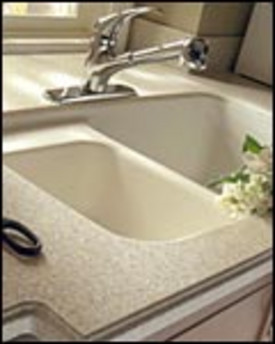 Solid-surface countertops come in a wide array of colors, textured looks, and profiles. Solid surface can be machined into all kinds of profiles, rounded and beveled edges, one-piece back splashes, and integral sinks. |
|
| Read more about countertop options. |
Solid surface is a 100 percent man-made product, which means great diversity when it comes to color and texture variations. It is made of resin, an acrylic or modified polyester; alumina trihydrate, a filler which allows for a Class 1 Fire Rating; color pigments; and added particles that give a mottled, veined, or textured look to the surface. Solid surface is machinable and can be cut into about any shape imaginable. It also can be heated and molded. Solid surface is the only material that features molded sinks seamed directly to the countertop with no gaps or caulks. Built-in coved backsplashes can be fused to the countertop to create a water-tight transition.
Various additives allow for the creation of hundreds of looks, from speckles of granite particles to the swirls of a marble vein. According to Russ Lee, Vice President of Surfacing for Fry Communications, marketing/communications agency for the International Solid Surface Fabricators Association, one product even includes metals that present a copper-like patina. Surfaces are available in finishes from dull matte to high gloss.
Solid-Surface Benefits
Solid-surface kitchen countertops offer homeowners the benefits of a warm-to-the-touch surface with low maintenance requirements, says Lee, a former solid surface fabricator himself. Normal wear and tear requires only soap and water cleanup.
Solid-surface products offer these benefits:
- Stain and chemical resistance
- Scratch resistance
- Easy cleanup
- Durability—The product is "homogenous" meaning the color and pattern are consistent throughout. There are no veneers to chip, crack, peel, or wear out.
- Long warranty. Solid-surface products generally come with a 10-year warranty.
Solid surface is manufactured to be stain, chemical, and scratch resistant, but it is not impervious to harm. It can be scorched and may crack if incorrectly installed too close to a high-heat producing appliance or if hot pans are placed on it. To prevent damage, homeowners are encouraged to use trivets or hot pads.
Wine, mustards, and other high stain producers could leave a mark if not quickly wiped up. Solid surface can be scratched and cut so homeowners are advised to use cutting boards. Damage can be repaired and the product restored often by using a non-woven scrubbing pad—such as Scotch Brite—or an or abrasive liquid cleanser followed by the pad to maintain the same appearance as the rest of the countertop. Always check with the manufacturer for their specific care instructions since care and repair options vary depending on the finish and the degree of repair needed. Deep scratches will probably require professional services, but repairs for cracks or chips can be practically invisible
The cost for solid-surface countertops is more affordable than one might suspect. It typically costs anywhere from $40 to $60 a square foot, but texture and pattern can affect the price. Regional markets impact pricing as well, Lee says, with the cost in the Southwest being half of what it is in the Northeast.
Solid Surface Brands and Installation
|
While the word solid surface may seem unclear to some consumers, the mention of various brands, such as the long-popular Dupont Corian, can bring more recognition. Aristech Acrylics’ Avonite Surfaces, LG Hi Macs by LG Chem, Hudson Surfaces’ Mystera, Chemcore Industries’ Dovaé, Wilsonart’s Gibraltar and Earthstone labels, Formica brand solid surfacing, Fountainhead, and Samsung’s Staron are some well-known brands. In addition, Eos Surfaces offers a product than comes standard in 3 cm. sheets—about 1¼ inch—instead of the typical ½-inch material. At that thickness, it does not require edge buildup.
Installation is almost exclusively by professional fabricators or countertop professionals, according to Lee. "The important thing, between factory and finished installation, is the intermediate step: the fabricator. The fabricator is the key." He says installing a solid-surface countertop is not typically a do-it-yourself project without prior training.
Most fabricators prefer to assemble much of the countertop in the shop to better control the process and quality. Shop-built counters have less potential for error and require less onsite preparation and inconvenience for the homeowner.
When your countertop arrives at your home, it may not be in one piece because of access and maneuverability factors. In those cases where an onsite seam is necessary, most fabricators use equipment fitted with dust extraction to keep the home dust-free. Specialized tools for clamping and finishing seams onsite also can be used to speed the process and improve the quality of installation.
The fabricated countertop will not be screwed in or nailed down. Instead it will be attached with dots of silicone caulk that will allow it to expand and contract. The drop edge or buildup will typically be created by cutting narrow strips (usually between 1 to 1½ inches wide) lengthwise from the solid-surface sheet and stacking, gluing, and clamping two strips together on the underside of the countertop deck, to create an edge that is 1½ inches thick. After the glue dries, the squeezeout—glue that has oozed out of the layered solid-surface sandwich and hardened—is machined off and a profile is routed into the edge and finish sanded, says Lee.
In a new house, installation may take a few hours. In a remodel, the process may take about a day. A cutting-edge trend that has begun in the New England area, says Lee, is a mobile fabrication shop. These fabricators are able to visit a site, create the template, fabricate the countertop and install it in about one day—start to finish.
More Countertop Resources:
- Concrete Countertops
- Quartz Countertops
- Stainless Steel Countertops
- Stone Countertops
- Wood Countertops
- Laminate Countertops
- Ceramic Tile Countertops
- Inspirational Countertop Gallery
- Cleaning and Maintaining Stone Countertops
- Install Ceramic Tile Behind a Countertop
- Countertop Trends
Credit: Renovate Your World





























